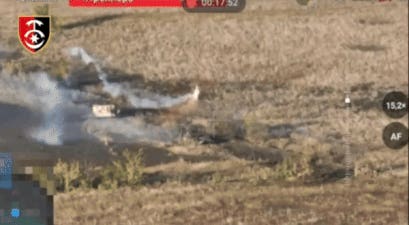In early September, Ukrainian forces began using hovering drones equipped with tanks full of thermite, a metal incendiary that burns as hot as 5,000 degrees Fahrenheit. Russian forces quickly developed their version of the Ukrainian “dragon drone” and deployed them a few weeks later. These dragon drones have mainly been targeting bunkers, trenches, and their occupants, using the sticky incendiaries to kill human beings within seconds. However, they have also proven effective against armored vehicles, as one Ukrainian brigade discovered in eastern Ukraine.
The Ukrainian army’s 30th Mechanized Brigade, stationed around Minkivka, observed a Russian tank from the North-V Volunteer Brigade moving along a treeline road in broad daylight. Ukrainian troops struck the tank with an anti-tank missile, immobilizing it and making it an easy target for further attacks. A Ukrainian drone then sprayed thermite all over the tank, turning it into a burning pyre. This incident marked one of the first documented cases of a dragon drone successfully targeting a Russian armored vehicle, showcasing the effectiveness of incendiaries as anti-tank weapons.
The use of incendiaries against tanks is not a new concept, as the U.S. Army had noted in a 2000 study that napalm could cause significant damage to tanks by igniting flammable materials on the surface, rubber components, and exposed hydraulic hoses. In cases where infantry is riding on top of the tank, the threat of secondary blast or fragmentation damage from ignited ammunition is also a serious concern. While the dragon drones’ incendiary spray may be inaccurate, the recent success against the Russian tank demonstrates their potential effectiveness in combat situations.
Although there may not be an immediate increase in dragon drone attacks on tanks due to the inaccuracies of the incendiary spray, drone operators in the Russia-Ukraine conflict are quickly adapting and learning from their experiences. Ukrainian operators of first-person-view drones have already demonstrated their skills by targeting Russian drones in mid-air or maneuvering explosive drones under the armored shells of Russian tanks. With time and practice, it is likely that dragon drone operators will become more proficient and be able to target enemy tanks while they are still in motion, further enhancing their effectiveness on the battlefield.
The successful use of dragon drones against armored vehicles highlights the evolving nature of drone warfare and the potential for drones to become increasingly important tools in modern conflicts. As operators continue to develop their skills and tactics, drones equipped with incendiaries could play a significant role in countering enemy armor and other military assets. The ongoing Russia-Ukraine conflict serves as a testing ground for these advanced drone capabilities, providing valuable insights for future military operations and strategies.


